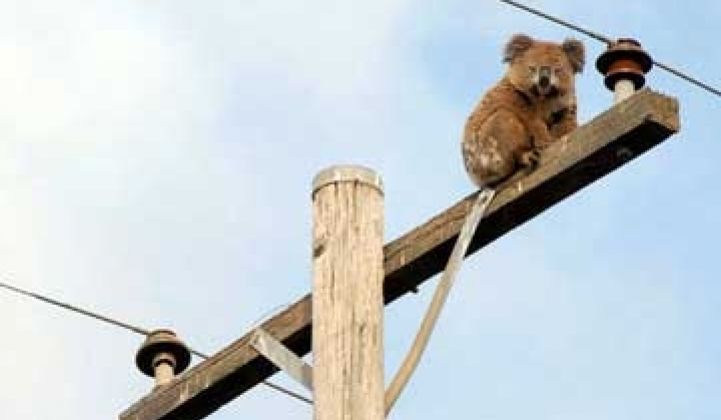If you look west of Wollongong and just east of Wagga Wagga, the future of bundling is here.
ActewAGL, a utility down under in Australian Capital Territory, or ACT, has roved far beyond the ubiquitous phone, internet and cable package offered to most U.S. consumers. Instead, the utility tosses together up to seven services, including electricity and natural gas, allowing for customers to save on bills.
Telecom companies stateside have been eagerly venturing into smart grid alliances. AT&T has offered up its wireless network to carry smart grid traffic with SmartSynch, and Comcast invested in home energy startup iControl, but utilities and telecom companies have not been not focused on teaming up to offer their services as a single unit -- at least not yet.
ActewAGL, which serves the national capitol Canberra and its surrounding area, was deregulated and opened up to competition in 2003, although electricity rates are still heavily set by government tariffs.
In an effort to stay cost-competitive, ActewAGL thought it was natural to start bundling the electricity, natural gas and phone services that the majority of their customers already had. The bundling options between the utility and telecom partner TransACT have grown since 2003, and the more services that are included, the more consumers can save. It’s mandatory to start with the basic three services, which saves three percent, but if customers add in green energy, cable, cell phone and internet, they can save up to 25 percent on either their telephone or electricity bill. The savings are capped at $500 (AUS) annually.
Bundle more, save more. The concept is familiar to most of us, but packaging kWh with phone minutes is not as intuitive as it seems. “We invested a lot of money in our systems and processes to make our customer experience as seamless as possible,” said Ayesha Razzaq, ActewAGL's general manager for retail. “It’s important to be able to do it seamlessly so the customers feel like they’re dealing with one company.”
Customers see their bill broken down by service, to avoid price shock. About one-quarter of ActewAGL's 135,000 customers are signed up for some level of bundling. Razzaq said the company has seen the rates of participation slowly increase over the years, and the appeal of sticking with the local guys -- both TransACT and ActewAGL only serve ACT and some surrounding areas -- has paid off.
“It’s a very unique model that I don’t think would work in other places,” said Kylie Van Steenbeek, the marketing manager for ActewAGL. “We have a whole heap of customers who have been there for a long time and are very local to the brand.”
Not only is ActewAGL local, it has a customer-service model from which some smart meter-embroiled utilities could learn a thing or two. When customers call up ActewAGL, a human answers the phone. Not a human-sounding voice -- a breathing, bipedal human. While talking about bundling with ActewAGL, the conversation constantly returns to customers, finding out what they want and discovering how to deliver new products in a user-friendly way.
Although the formula may not be easily replicable on a larger scale, telecoms and utilities are still bound to move beyond back-end partnerships as smart grid applications enter the mainstream.
The potential appeal of customers checking their energy use on a flat screen TV is certainly just one incentive for Comcast, Verizon and other cable providers to offer energy management portals over their networks. T-Mobile and AT&T would probably like to see customers manage energy over their smart phones and networks, too. EcoFactor, a Calif.-based energy management startup, is betting that a broadband gateway, and not smart meters, will be how consumers will manage their energy use at home in the future.
Australians are notoriously green-minded and light years beyond most Americans in terms of how they think about power and water consumption, so any partnership like the one in ACT might not appear in the U.S. for some time. After all, other Australian utilities have not even replicated the bundling services.
Despite the bundling partnership, the alliance down in ACT surprisingly ends at monthly savings. TransACT does not have arrangements for smart grid start-up projects or demand response networking, despite the fact that ActewAGL currently has a smart grid pilot with an in-home display made by EcoVision.
That could change in the future, however. Because it already has a successful partnership in bundling services, TransACT could be a natural partner to provide broadband networking if ActewAGL wants to update or expand its grid communications.
The move in the other direction by U.S. companies, from smart grid network coalitions to consumer partnerships, will most likely be marked by baby steps. A lesson from Down Under when it comes to bundling is not to lure customers into new smart grid applications by packaging them with existing technologies. Instead, build confidence with what customers already know and have, and then let them add in products over time. “The services are ones people have already,” said Razzaq, “so it’s not asking people to make a jump into solar panels right away.”
Networking/AMI

Bundling Energy and Telecom Down Under
Aussies package everything from your home phone to natural gas in one bill.

Bundling Energy and Telecom Down Under
-
42Where Will DOE’s Loan Program Make the Next Climate Tech Investments?
-
15What the Frack Is Happening With Natural Gas Prices?
-
9With an Energy Crisis Brewing, No Peak in Sight for Emissions



